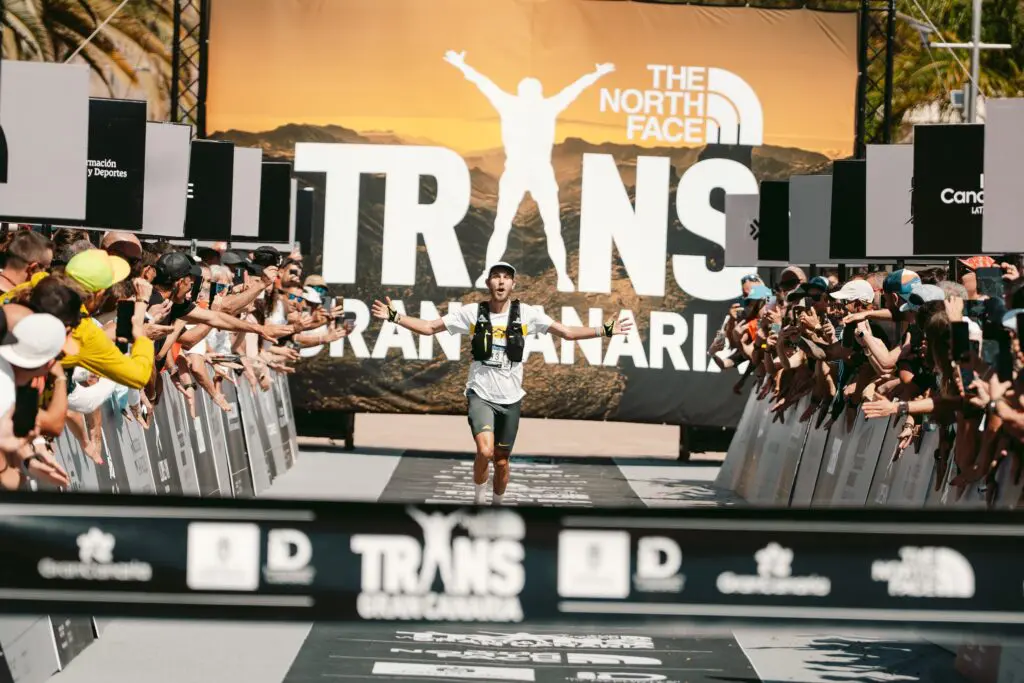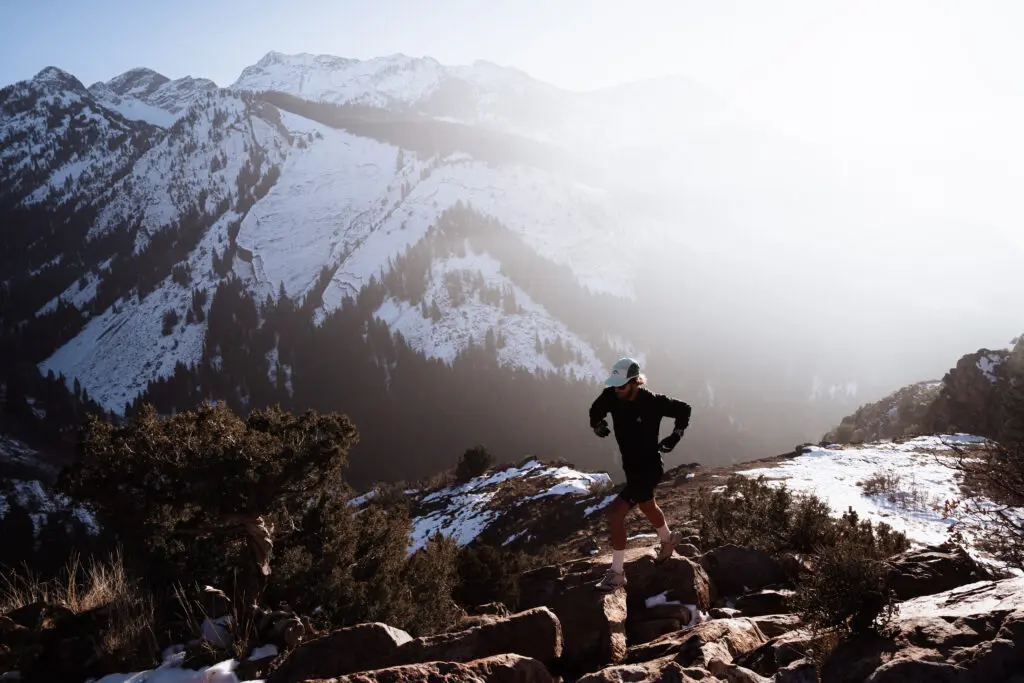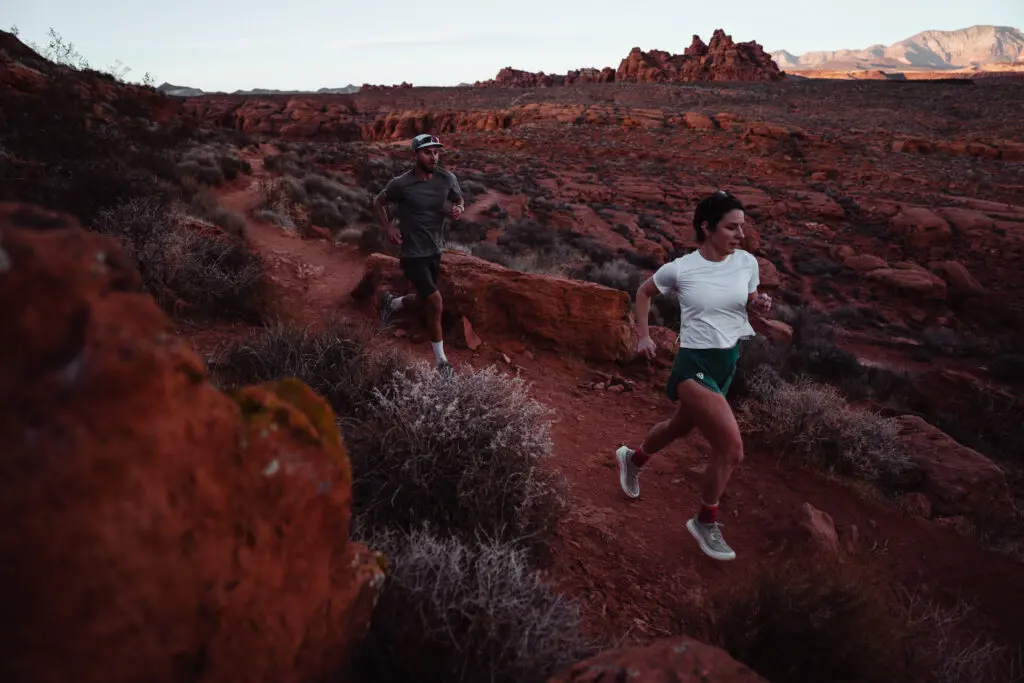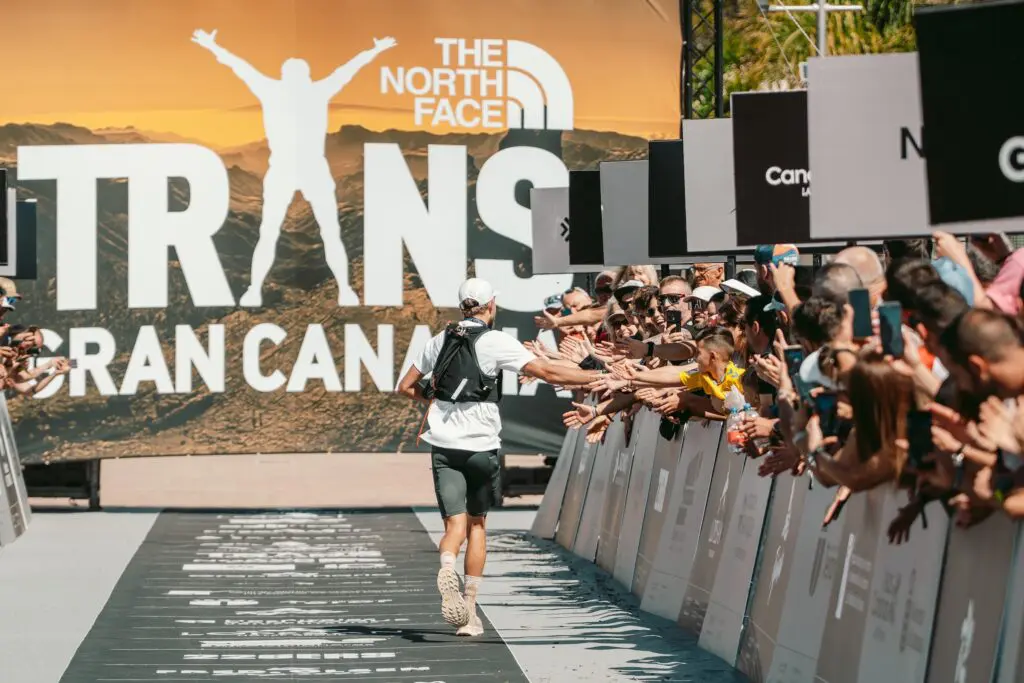Caleb Olson’s Build to a Course Record at Transgrancanaria
By: Jack Kuenzle
Posted:

This article details my (Jack Kuenzle) coaching relationship with Caleb Olson, using his build towards the Transgrancanaria Classic 126K as a case study. Caleb’s run, in 12:17:25, not only earned him first place, but a huge course record (albeit on a slightly shortened course). This article covers his four month build, from initial testing to final taper, and closes with some short reflections on the race and moving forward.
Initially, Caleb and I disagreed on even doing Transgrancanaria. First, I felt Caleb would burn out running year round, either physically or mentally, and could benefit from a cross training heavy off season. Personally, as a trail runner and a skier, I could not imagine anything worse than training for a desert race in Salt Lake City in the winter. Further, I felt Caleb could benefit from a base building off season. Caleb had little experience with weight lifting or with high intensity, “Zone 4 or Zone 5” work and I felt a targeted off season focused on these non specific stimuli could be valuable to improving his fatigue resistance and running economy.
I quickly learned that Caleb and I were very different people. Whereas I prefer to train alone and get all my enjoyment from stacking great sessions and huge, varied sessions in new and exciting locations, he really enjoys training with other people and sharing a goal with other athletes (weird I know). He explained that Transgrancanaria was an objective that his friend group was training towards and forcing a cross training season of skiing may actually be more mentally taxing than enjoying a running season, in the snow with friends. When I said racing TGC was too early and made for a season that was too long, he explained that the fun he would have training and racing with friends made up for the longer season. On the other front, the lack of historic weight lifting and high intensity work, we agreed to start the build and see how things progressed and explore his deficits there and how necessary a long dedicated non specific block would be.

Transgrancanaria is a mountainous, point to point, ultra marathon held in the Canary Islands in late February. The race, 126K/79 miles with 6260m/20,000 ft of climbing, is steeper than Western States, but less steep than UTMB, roughly in line with Lavaredo Ultra Trail. It has a midnight start and features a decent balance of running and hiking. The course is unique as the first two thirds of the race are overwhelmingly net uphill, starting at sea level and reaching an elevation of 5700 ft, before a long, nearly continuous downhill in the last third of the course to the finish. Held in late February, race day typically has a high temperature of 70°F and a low of 60°F. Typical winning time is around 13 hours, with a 7:30 AM sunrise, the winner could expect to run a little more than half their race in the dark and half in the sun.
Here is an overview of Caleb’s build to TGC, I have highlighted the weekly key sessions.
None of these key sessions were done on back-to-back days. It’s important that Caleb recovered between them so that the sessions were high quality.
I decided it was important to do some baseline testing to get a feel for Caleb’s current fitness. An added benefit of testing at the beginning of a training block is establishing a baseline of fitness that you can later test against. The tests I decided on with my rationale:
From these tests, I concluded a number of things. First, Caleb’s flat running economy and aerobic capacity were quite good. Second, his uphill running economy and uphill aerobic fitness were relatively worse than his flat fitness. I decided that any training block would need to target uphill stimuli primarily.

While this article focuses on the key sessions that Caleb did, these were done in tandem with a relatively high volume of base aerobic work. This base work focused on terrain similar to that of TGC and we shot for a similar mileage to vertical gain/loss ratio as he would see on race day (skewing slightly steeper).
Through the initial testing, we determined Caleb’s first lactate threshold and set this as an absolute maximum for base work. For an extremely aerobically fit athlete like Caleb, just using this as a limit for base work is far too aggressive as running in zone 2 would likely be far too taxing for his easy mileage. I find communicating how hard base work should be is one of the hardest things for a coach. I don’t like using heart rate to determine base work intensity beyond using the first lactate threshold as a limit, as dehydration, recovery status, heat, and other factors can all change how heart rate manifests relative to the stress imposed by base work. On the other hand, using pace targets alone isn’t sufficient. Even if Caleb was training 100% on flat roads, perceived exertion and stress is rarely perfectly correlated to pace day to day and week to week.
The first thing I tell an athlete like Caleb (aerobically fit, not time limited, training for ultras) is that base work should not feel hard. The focus is always on the key sessions. In my opinion, too many elites do their base work too hard and do their speed work too easy. If the base work is done too fast, the speed work doesn’t impose the goal stress. Second, we established an upper bound for the paces I wanted Caleb to hit during base work. He could always go as slow as he wanted, but I didn’t want to exceed a certain grade adjusted pace during base work. The last rule we had was if Caleb was feeling fatigued, the first thing we cut was the base work. If we reduced the aerobic volume and he was still feeling tired, then we reduced the stress of the key sessions.
For gym work, I am a big fan of Jim Wendler’s 531 training structure. It’s a basic powerlifting protocol that emphasizes formulaic weight and rep structures on a monthly cycle. It’s excellent for building strength and the As Many Reps As Possible (AMRAP) set every session provides an excellent check-in to see how an athlete is handling the training adaptations. I started Caleb on a 531 routine to strengthen his legs broadly. I used back squat as the primary movement with Bulgarian Split Squat and Romanian Deadlift as the accessory movements, strengthening both the anterior and posterior chain. After just five sessions, Caleb’s numbers squatting indicated his “barbell” strength was already beyond that necessary for elite competition ultra trail running and we could move on to different stimuli.
Paired with those lifting sessions, Caleb did six weeks of hill sprints. These sessions were quite simple, warmup, and then execute 12 12 second hill sprints on the steepest hill you can find with decent traction under foot. The goal here, like lifting, is to improve the central nervous system’s ability to recruit muscle fibers when running. Ultimately, better recruitment is better power output and better power output means a longer stride length, better running economy, and higher speed at all intensities.
In any training block, I have two primary aims: to make the athlete more efficient and to make the athlete more fatigue resistant. A fantastic way to build that fatigue resistance, or muscular endurance, is hiking uphill with a heavy pack. Personally, I prefer to do these sessions on the stair stepper or incline treadmill for a variety of reasons (consistent slope angle, perfect traction, no adverse weather, slope is infinitely long, ability to keep nutrition immediately at hand) but Caleb preferred to do these outdoors. I think this is in line with our different philosophies. For me, it’s first important that the training is enjoyable so I agreed that Caleb should do these sessions outside.
While these sessions, hiking with a heavy pack, may not look specific for ultra running, I think these played a key role in Caleb’s success. Your musculature isn’t just made up of a binary of fast and slow twitch fibers, it’s more of a spectrum, with different fiber types suited for different kinds of efforts. In these weighted sessions, the goal was to fatigue the fast-twitch oxidative fibers, ones that play a key role in speed endurance, by pushing Caleb to the edge of his sustainable effort. These fibers are often the bottleneck for performance in long, hard efforts like the repetitive climbs of TGC, and training with weight helps us target these fibers and improve their aerobic capacity and resistance to fatigue.
Initially, we did these in a couple of different locations in SLC and then standardized the West Grandeur trail. Each week, we gradually increased the stress by raising the vertical speed, pack weight, or time at intensity. Caleb began with two 20 minute working bouts separated by five minutes rest and slowly worked up to one 60 minute working bout. We gradually increased pack weight from 35 pounds to 50 pounds. By the end of the block (ten sessions) Caleb was able to hike for 60 minutes at 50 pounds faster (vertical ascent speed) than the initial session of 2×20 minutes with 35 pounds.

These sessions, 40-80 minutes of work done in high zone 2 and low zone 3, are central to the Norwegian Training Method and are the bread and butter of any ultra runner’s training. The primary goal here is to improve the aerobic capacity of the working musculature broadly, improving mitochondrial and capillary density. The paces aren’t quite as high as hill sprints, so the running economy stimulus isn’t as large, but there is definitely a stimulus here for improving running economy. I also had Caleb consume his race nutrition slightly above race intake levels during these sessions to get a bit of GI stimulus and to ensure the work was quality and recovery was optimum.
For these sessions, we started at 6×6 minutes on a 1 minute rest and gradually progressed the time at intensity and length of the working reps until we hit 9×7 for the final session, also on a one minute rest. This session is harder to do outside in the winter, the best location that we found was up either the Little Cottonwood or Big Cottonwood roads. I would have preferred a little steeper, but these almost always had good traction and were fairly consistent in their slope angle. I’d say one other problem with doing these sessions outdoors in the mountains is that if you respect the rest interval and don’t have time to run down between reps, you will do much of this workout at a very high elevation. Caleb was often starting in at the mouth of the canyons (~5000 ft) and finishing up by Alta or Solitude (8000 to 9000 ft). The higher elevation limited power output a bit in the latter half of these sessions but, I suppose, may have had a bit of an altitude stimulus (especially when coupled with the heat work).
This is a session I have only started incorporating personally and with my athletes in the last year. When I was training for the Grand Canyon last fall, because of that route’s unique geography (starting with a long downhill), I came to appreciate the damage a long downhill can do to an athlete’s central nervous system and musculature. Talking with Scott and reflecting on his success with Tom Evans and Ruth Croft implementing downhill specific workouts, I started adding some of these sessions into my own calendar. I think the best way to do these is with a tram (Snowbird in SLC in the summer and fall) or with a car shuttle, but they can also be done without these tools.
For these sessions, I had Caleb do a three to four hour long run and just push hard on the descents. Actual paces varied a ton based on terrain and conditions and heart rate wasn’t much of a guide here, so Caleb really had to do these off of feel. We’d aim for 6000 to 9000 ft of descending. From personal experience, these sessions are enormously destructive. You have to be very careful how you integrate these and ensure you don’t have any key sessions at least in the first 48 hours following a session like this. But they are absolutely critical in moving well in a long, steep trail race, especially one like TGC that finishes with a massive, multi hour descent.
This was another workout heavily based on feel. I’d say on any week, this session was actually the lowest priority. It’s easy for a session like this to turn into “race simulation” and basically just the athlete running themselves into the ground every week, especially attractive if the athlete is posting the effort on Strava. I told Caleb just to push this session a bit higher in zone 2, never above aerobic threshold. From this session, we got a little bit of everything. A little bit of a strength ME training effect from running the downhills a bit harder. A bit of a lactate buffering training effect from pushing climbs in zone 2. A bit of a running economy training effect from pushing a bit faster on the flats and uphills. Finally, some practice fueling well, not only pushing the upper end of Caleb’s nutrition intake but practicing moving smoothly and fueling on the go without stopping.

Because Caleb’s flat running economy was already quite decent coming into this block, improving there wasn’t a major focus. I knew just a couple of sessions, conducted immediately before the race, could really sharpen him up and improve his economy, maybe not to a personal PR but at least elevate it to near his best historically. We did three sessions of 12x200m on a 2-3 minute rest, really focusing on recovering completely between reps and pushing maximum power output during the working bouts.
Caleb has a sauna and a stationary bike at home, which makes things easy. All throughout the block, Caleb was in the sauna three to four days per week, always on the same day as the key sessions after all other training was complete. The goal here was primarily to form a base for later active heat training, but also to increase blood volume and hopefully get a bump in total hemoglobin mass and oxygen carrying capacity. Starting in mid-January (~six weeks before race day) we began converting these passive sessions to active heat exposure. Caleb would get hot for roughly ten minutes in the sauna and then, once his core body temperature was slightly elevated, hop on the stationary bike overdressed with extra clothes. We gradually converted all of the weekly sauna sessions to these active exposure sessions. Because TGC isn’t a terribly hot race, we didn’t dive into higher intensity work with heat.
Caleb’s performance at TGC I feel was a huge breakthrough for him. He took on some of the best in the sport and came out the clear victor. He put in so much training in this block, lots of unpleasant running on slushy snowy trails, and it really showed in the end. I am so proud of him and grateful to be his coach. We came out of TGC with some awesome takeaways and things to work on. Caleb’s next race will be Western States.
